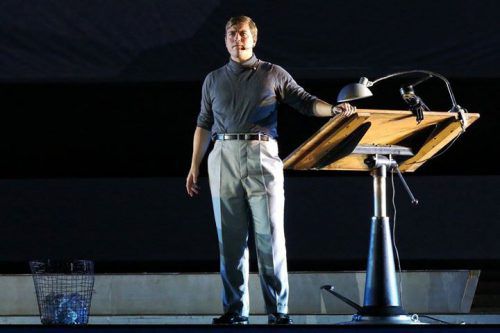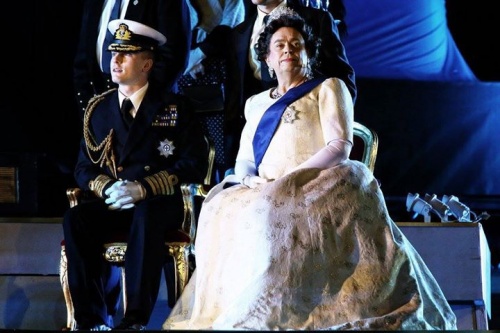
It has a protagonist every bit as brilliant and as inflexible as Oedipus in the character of ‘The Architect’, surely none other than Joern Utzon.
It has a huge building, the most famous in Australia, an “Eighth Wonder” for the world, hovering over us throughout latest production and creating a most curious sensation as real life juxtaposed with what we saw onstage.
Small matter that apart from the NSW Premier, who commissioned the Opera House, no one dies, or not within the confines of Alan John’s opera, premiered in 1995 by Opera Australia, revived in 2000 during the Sydney Olympics Arts Festival and now restaged spectacularly on the forecourt of the Opera house itself.

As well, students from the UNSW Built Environment School had created an environment that included a 3D-printed bar table, Hills Hoists and an exhibition of Max Dupain’s photographs of the construction of the House.
The onstage design that featured large amorphous sculptures with architectural drawings and lit from within, sliding stages moved by hard-working mechanists and a huge inflatable upstage screen that looked more like a jumping castle, wavering at moving with the wind as projections of the Opera House, the previous sheds on the site, an Aztec temple and Utzon’s plans as tech temples appeared high above the audience.
Opera-goers accustomed to the 19th century conventions of unmiked singers and naturalistic scenery quickly got used to the fact that through the provided Audio Technica headphones they could hear every word, crystal clear, and thus enjoy the thematic content of the opera, which presents Utzon as an Aztec-style sacrificial victim to the forces of Aussie mediocrity and bureaucracy.
The ambience of Sydney’s harbour was inescapable, but nonetheless director David Freeman introduced a number of comic scenes showing Sydney’s beachside culture, an Aussie family barbecue, scenes of provincial snobbery and, in an almost cruel piece of casting, Gerry Connolly as an altogether too “gracious” Queen Elizabeth.

Another creative spirit is seen in the aspiring young fictional soprano Alexandra Mason, played by Stacey Alleaume. Although it is arguable that this subplot is superfluous to the main theme, her transition from intimate scenes to passionate expressions of longing and a wonderful duet with the architect, brought to life the idea that only a few people really cared. It is to her that the architect explains how this country needs something more than material success.
A small team of well-known singers played more than 40 characters, providing an additional treat in their out-of-character vignettes, including Jermaine Chau as Madame Magna the fearsome singing teacher, Samuel Dundas as Politician/Reporter, David Greco as the treacherous Engineer and Adrian Tamburini as The Maestro.
It’s a solid night at just under three hours with one interval, but there’s plenty of food and entertainment to make it total experience such as one rarely experiences in the opera world.
At interval I met a mother who had brought her seven-year-old son and was taking him through the Dupain photos and explaining it – neither had ever been to the opera before but seemed intrigued.
Possibly such newcomers may be daunted by the raw and transparent passions, the kind of emotions you couldn’t possibly show in a straight stage play, a film or a musical – big thoughts to be played in a big way.
Who can be trusted?
In a world of spin and confusion, there’s never been a more important time to support independent journalism in Canberra.
If you trust our work online and want to enforce the power of independent voices, I invite you to make a small contribution.
Every dollar of support is invested back into our journalism to help keep citynews.com.au strong and free.
Thank you,
Ian Meikle, editor




Leave a Reply